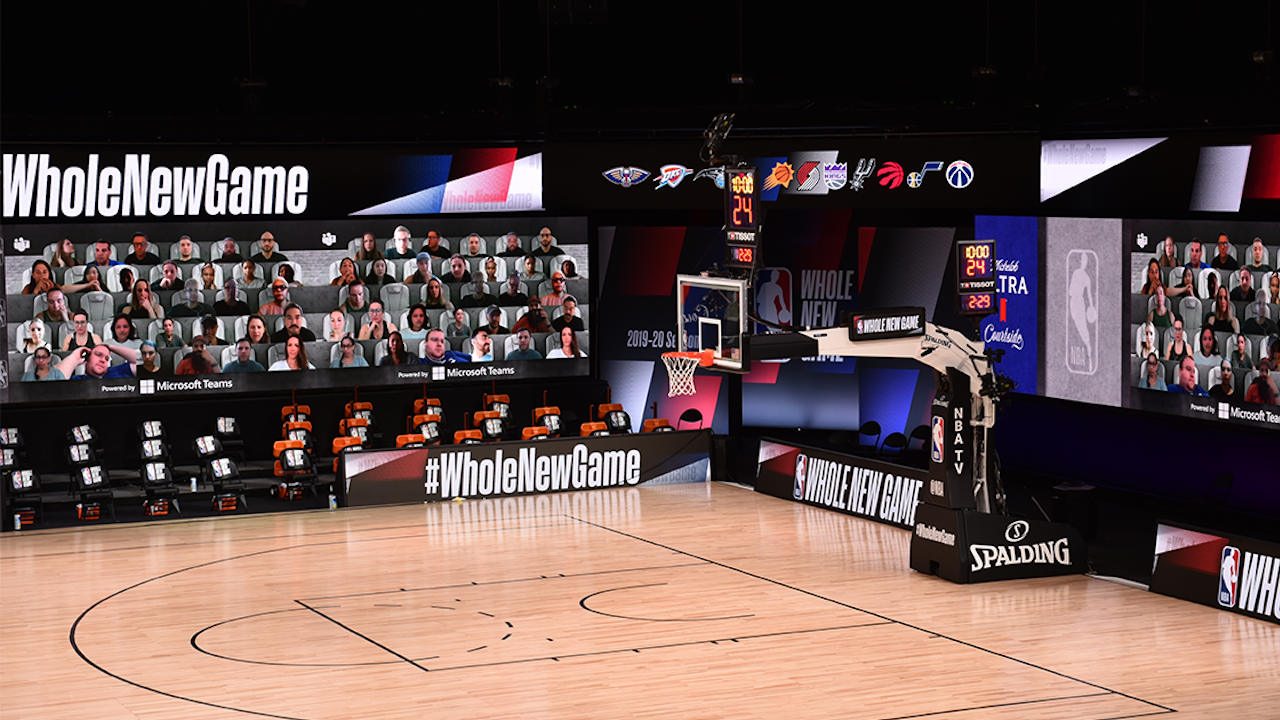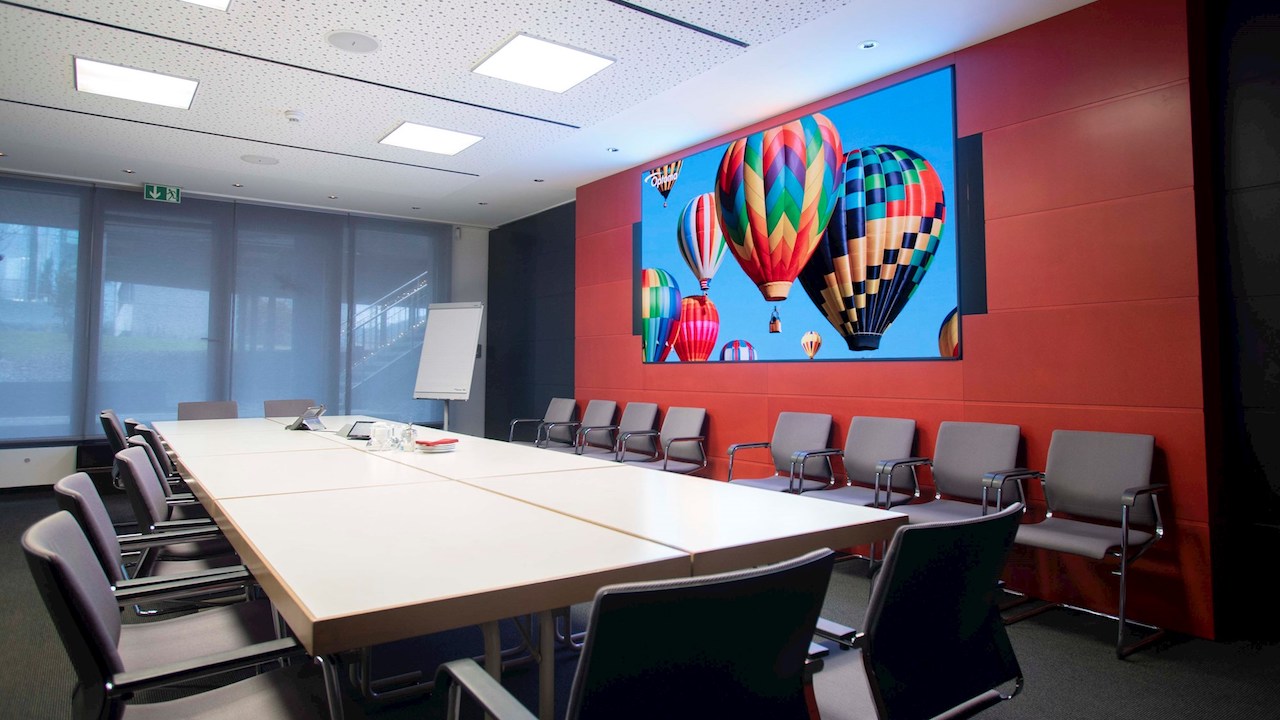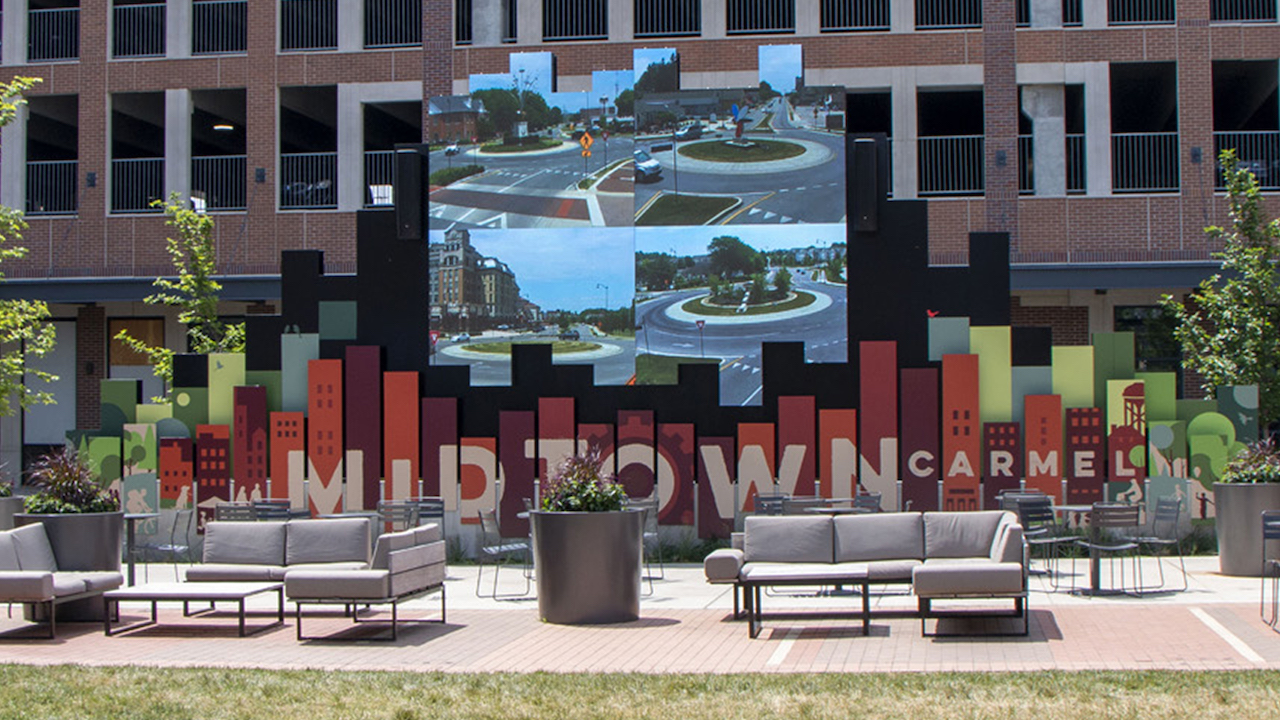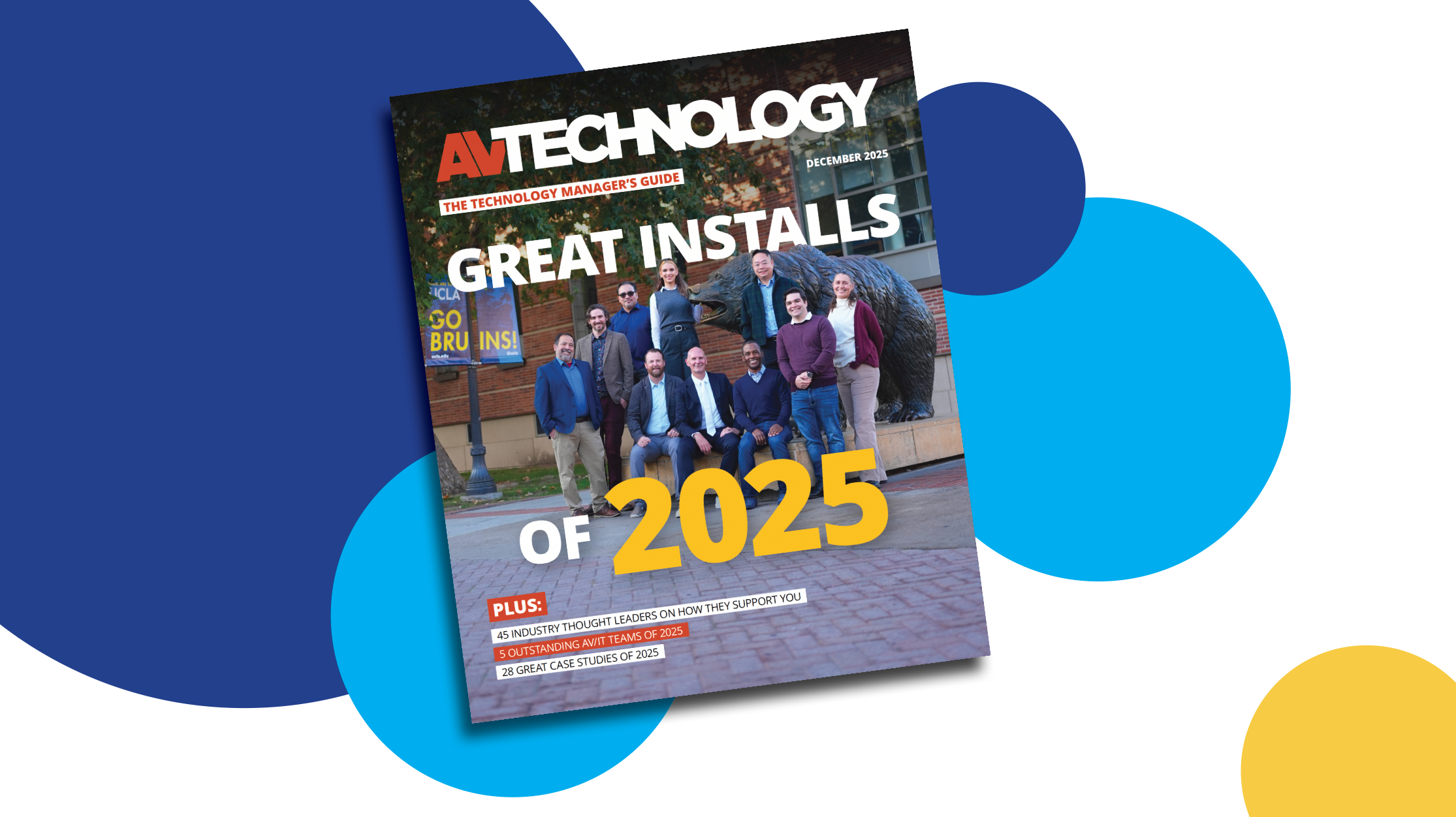How Video Walls Can Bridge the Virtual Chasm

Face-time is a critical component to human interaction and communication. Because of COVID-19, for months, we’ve been using Zoom, Microsoft Teams, and Google Meet to conduct virtual meetings to replace in-person interactions. We’re all “Zoomed-out,” but without the ability to make a “personal” visual connection, who knows if we would have been as productive or even stayed remotely sane? And it’s not over yet.
Since March, with the aid of remote technologies, businesses continuity has been managed in many organizations, but for non-essential workers requiring human contact many businesses were completely sidelined.
With franchise owners and sports fans clamoring for teams to begin playing again, on July 30, the NBA resumed the 2019–20 season with 22 teams competing at the “NBA Bubble,” a hub based at Walt Disney World's ESPN Wide World of Sports Complex in Orlando.
In this surreal world without fans filling the stands, the NBA turned to Microsoft, which in April had entered into a multi-year alliance with the goal of creating next-gen experiences for basketball fans. But nobody had planned on needing to create a completely virtual fan experience.
Three game courts at the bubble were outfitted with 17-foot-tall LED screens that wrap three sides of the arena to display seating that is populated with more than 300 virtual fans. “We are excited to announce a reimagined fan experience powered by a new feature in Microsoft Teams called Together Mode,” said Jared Spataro, corporate vice president for Microsoft 365. “Together mode uses AI segmentation technology to bring people together into a shared background like a conference room, coffee shop, or arena. Using scientific principles of cognition and social perception, Together Mode is more than a virtual background; it makes being together virtually actually feel like being together in person. It’s easy to maintain natural eye contact, for instance, or register fellow participants’ emotions as they react to what’s happening—whether it’s a meeting announcement, a class presentation, or the sight of a favorite NBA player about to score a three-pointer.”
Go Big and Stay Home
The red carpet never looked so… Well, there wasn’t one.
Like a scene straight from a Hollywood sci-fi movie, more than 100 nominees and presenters of the 72nd Emmy Awards were live-streamed and displayed onto a massive curved video wall creating a virtual ballroom surrounding show host, Jimmy Kimmel.
A daily selection of features, industry news, and analysis for tech managers. Sign up below.
While the NBA moved its games to Disney, for the evening of September 20, Hollywood moved into the Staples Center, the massive L.A. arena that’s home to the NBA’s Lakers and Clippers to create a stage made up of billions of pixels.
The staging of virtual events is becoming the norm, as is the need for sharing information on a large visual scale. How else are video walls helping to elevate experiences during this time of distance interaction? We reached out to display manufacturers to find out.
Absen
James Liu, President

Budget restrictions caused by the pandemic greatly impacted the LED market as manufacturers began to offer more cost-effective solutions in an effort to adapt to the changing environment. Once the outbreak is under control, we expect demand for indoor LED displays to gradually recover and eventually return to pre-pandemic sales levels. One segment of the market that has thrived is houses of worship. With congregations not meeting, church leaders are using the time to make changes to their sanctuaries before the congregations come back and installing new video walls for a more dynamic experience.
As indoor close-view and ultra-high-resolution applications grow, Mini LED is becoming a more reachable technology and running into mass production. Integrated mounted devices (IMD) technology, a type of mini LED, is providing high durability, good contrast, and an affordable life-cycle cost. It is also leading in the field of fine-pitch LED display.
The content we see in the traditional display is virtual, but it is coming into “reality.” The extended reality technology is the connection point. LED display could create a larger and more impressive stage. With the combination of floor, surrounding, and ceiling video walls, the audience will easily get a real and immersive experience. A good example of this technology can be found in Disney’s The Mandalorian and other virtual studio applications.
For outdoor solutions, applications using video walls are also approaching the fine-pitch quality of indoor solutions, as the technology of heat dissipation and environmental factor resistance develops. Predictably, the usage of outdoor-rated video walls will be further extended with higher resolution and brightness.
Stepping into the 5G era, we are within a revolution of increasing data and transfer speed. The world is connected by information, and LED display is one of the terminals to show and exchange the massive amounts of information. The extended bandwidth can also increase the capacity of the LED system itself—fewer network ports, cables, control equipment, but more pixels.
Barco
John Steinhauer, VP, Entertainment and Visualization

Large video walls employed smartly in flexible spaces are key to effective collaboration, communication, and customer experience with the emergence of hybrid workplaces. Collaboration will continue to be key, but those casual “over-the-shoulder” moments will be less possible. For this reason, larger displays will be a key to increasing visuals, sight lines, and distance.
With increased distances and realignment of spaces, we will need larger format displays, with more of them doing heavy lifting beyond just showing spreadsheets. Flexible and multi-use visualization products such as UniSee and LED XT are terrific technology touchpoints for promoting safe, agile, and productive collaboration.
Prior to COVID, lobby video walls were about branding and messaging. But now they are also important as initial touchpoints for safety protocol as well as corporate reassurance. Similarly, experience centers will see a shift to more video wall usage as virtual demos take precedence over in-person. Boardrooms will continue to be the venue of choice when customers, partners, and boards of directors can meet in person. There will be an expectation that these boardrooms offer the finest technology available as the place where the company’s image and promise is conveyed (like lobby walls, but more collaborative). Again, the “wow” factor is of utmost importance, as you only have one chance to make a first impression.
Razor-narrow-bezel (RNB) LCD display and direct-view (DV) LED are the biggest stories in display technology. B2B customers have progressed toward technologies that minimize the bezel as much as possible (RNB) or eliminate it (DV LED), as it is seen as a distraction from the message and the ambiance of the environment.
High-res direct-view LED like the LED XT series is currently at the growing stages of being a highly desirable video wall technology. The trouble is that the market is being flooded with the vestiges of outdoor LED manufacturers trying to quickly recognize sales, and this has added confusion to a market that is much more sophisticated and complex. LED is a professional technology that requires a professional approach and processing.
Christie
John Dixon, Senior Product Manager

COVID-19 has highlighted the important role that video wall technology plays in many critical applications and environments today, and the pandemic has impacted how different organizations use video walls to visualize information and data.
Examples of video wall uses we have seen from our customers include a network operation center (NOC) that is managing changes with usage and remote users; utilities companies are managing the changing dynamics of energy usage; and government and military organizations are managing and monitoring personnel and equipment. While many of us have managed through the pandemic by working from home, many who work in critical operations have maintained and or increased the use of the video walls.
Christie’s lineup of video wall products includes MicroTiles LED and Extreme Series tiled LCD video walls, which deliver mission-critical features and capabilities. Our MicroTiles LED products are designed with redundancy and a system level architecture that delivers no-compromise performance and zero-downtime capabilities. Christie Extreme Series also features some mission-critical capabilities, including a remote redundant power supply and remote monitoring capabilities.

CineMassive
Tom Polivka, VP of Sales

Examining the role of video walls and command centers in the age of COVID, the most obvious use case is the emergency operations center (EOC)—typically designed to coordinate and monitor incident response in various municipalities. Helping to build, replace, and modernize EOCs over the years, we saw everything from small closets with a handful of servers and terminals to larger conference rooms where managers huddled to receive updates and status from small video walls with semi-fixed layouts. In smaller communities without dedicated EOCs, we also saw real-time crime centers (RTCCs) and other control room operations repurposed as communities scrambled to monitor and respond to COVID and other urgencies.
Today, regional video wall operations must become multi-function hubs for reacting to coinciding crises. With COVID adding further strain on first responders, we’re seeing RTCCs, 9-11 dispatch, and traffic control all contributing to cooperative incident response.
The traditional command center model of sequestering dozens of operators in a purpose-built environment flies in the face of social distancing guidelines. Working with DoD commanders in the battlefield, we realized early on that command and control strategies could not assume that all decision makers were in the same room. As a result, we had to develop various methods for viewing, sharing, and controlling video walls from outside the command center—methods that have helped today’s operations comply with COVID-related restrictions.
Social media has become the de facto two-way communications channel—linking first responders, control room operators, and citizens. Every aspect of incident monitoring—crime response, dispatch, traffic status, weather emergencies, et cetera—depends on social media. Forward-thinking control room designers are now turning to small, dedicated appliances that offload web processing from the video server and allow operators to directly interact with—not just view—web applications from the video wall.
COVID and other converging threats have hastened the adoption of a global common operating picture that simulates a “single pane of glass” and provides situational awareness. At the same time, video wall access and operations are moving offsite to accommodate new restrictions around social distancing. Of course, this must be accomplished without impacting decision making by key staff that aren’t always co-located with the video wall. Finally, we’re seeing the rapid emergence of regional fusion centers that promote coalitions and cooperative monitoring and response between adjacent communities.
LG Business Solutions USA
Dan Smith, Vice President of Business Development

Every business—whether it’s service, food and beverage, retail, or beyond—has implemented new safety procedures. But it’s all meaningless unless they’re able to effectively communicate to customers what those procedures are.
So many of our interactions—whether commercial, functional, or interpersonal—are taking place at a distance. With all the different forms of social distancing being practiced, people are not necessarily located near the important messaging they need to see. That, combined with our tendency as humans to occasionally ignore signs that are not visibly captivating, means that businesses need attractive methods for communicating key messages. Video walls are among the most vibrant, engaging formats in commercial signage and can help make sure audiences—even at a distance—will take note of the critical messaging businesses need to communicate.
We’ve seen that businesses are purchasing new video wall products or modifying their existing technology. Along with our partners, we have been offering businesses effective video wall technologies that are crucial to clearly communicating rules and limiting staff interaction with customers. While technically there are other ways to communicate, such as through mobile devices or apps, the reality is that most people probably wouldn’t download an app every time they walk into a new business. video walls are the most practical and effective option in most cases because they are ubiquitous and easy to read.
Before COVID, the purpose of video walls was much more advertorial or aesthetic in nature, with the intent of driving promotion or influencing sales behavior. Now, many video walls are displaying critical health and safety protocols. Many of these displays are focused at entranceways. The goal is to communicate this information as early as possible.
With every emerging video wall technology, manufacturers aim to accomplish a few common goals: fast installation and follow-up maintenance, consistent performance, and superior appearance. With our two 55-inch LCD video wall panels, released earlier this year, we’ve checked all the boxes.
Both of our 55SVH7F and 55SVH7PF models include an ultra-thin 0.44-millimeter bezel to enable depiction of content without any distortions, and each panel features LG’s IPS panel technology that delivers a 178-degree viewing angle for excellent visibility from virtually any position. The panels also include an image improvement algorithm that can adjust the appearance of objects on the bezel boundaries to reduce image gaps among tiled displays when playing videos.
They also combine LG’s leading IPS technology with our automated Smart Calibration tool. The tool, which uses an embedded light sensor and calibration chipset to measure each panel’s brightness and color reproduction, automatically makes adjustments to ensure uniformity across all panels. This calibration procedure requires no external tools besides the included remote control, and amazingly, can be completed on a 3-by-3 video wall in as little as three minutes— offering time and maintenance cost savings of up to 97 percent.
To ensure 24-hour performance reliability of every panel, the 55SVH7PF additionally features external power boxes with hot-swappable power supplies, with each box containing four power supplies but only requiring three for operation.
NanoLumens
Derrick White, Business Intelligence Expert

The shift we're seeing is quicker adoption of large-format video walls. Public spaces and even conference rooms are utilizing the larger format so viewers can spread out rather than converge around a single smaller display. This trend is likely here to stay, as it also alleviates other issues such as traffic flow, design, and ultimately everyone likes a little more space.
There are two primary areas where display technology is evolving: the advancement of the video performance of display technologies as well as a push for a more hygienic experience coming out of COVID.
Video performance will be the evergreen advancement in display technology. Just when 4K comes out, you hear the announcement of 8K. What we are seeing is the trend for more ruggedized displays through GOB-based coatings and a focus on video performance, such as 12-bit processing, HDR, and color reproduction. As the market better understands digital displays, the potential gets accelerated.
The other area we are seeing advancement is around a more hygienic experience. Before COVID, the entire world revolved around touching a screen, which was only adopted after the invention of the iPhone in 2007. In the last 13 years, we’ve rapidly converted to touching everything almost to a dependent state, and now in six months, everyone shudders when thinking of touching something someone else has. Ultimately, touch is here to stay until gesture advances rapidly enough to become second nature, but for now, we are seeing companies introduce antimicrobial coatings, more sensitive touch solutions, or even a little sanitizer dispenser, which is probably the most logical.

NEC
Adam Sowers, Consultant Relations Manager, NEC Display Solutions

Next-generation operation centers can take many forms: power grid companies, social media, network operation centers, etc. We’re seeing that increase in demand due to the COVID-19 pandemic, but I don’t see the demand going down post-COVID. As we all try to find a sense of normalcy, video wall technology will continue to grow to help us get to whatever that “normal” will look like. Whether we’re looking at education, healthcare, public safety, or any number of uses, the technology gives us a way to explore that data from hundreds of different sources in one visual canvas.
As technology gets better, resolution gets better and the tech gets even more useful every day. From projection to flat panel monitors and/or the latest direct-view LED, the number of pixels we can put on one video wall canvas continues to grow. This allows users to review crystal-clear data, images, and video from multiple content sources simultaneously—naturally leading to higher efficiency.
The amazing thing to me is that many people say projection use in video walls is going away, and it’s quite the opposite. Projection continues to grow and become a large element in these next-generation video wall applications. Flat-panel LCD monitor models with ultra-narrow bezels also play a huge part, but the real growth is with direct-view LEDs entering the space. We are now sub-one-millimeter pixel pitch, and I see that continuing to grow smaller and smaller. As we do that and resolutions increase, the amount of content we can put on one single canvas increases. Gone are the days of blurry images brought in from an outside source. Now, increased pixel counts and resolutions result in great quality images on a large canvas without having to switch back and forth across multiple sources.
One canvas can display crystal clear images from multiple camera sources simultaneously. The other piece that I see is in the video management platform. These platforms allow users to manage and lay out images from hundreds of sources, while customizing the output. It’s incredibly important to use the hardware and software correctly upfront to ensure a positive user experience; if one of these is off, the result can be catastrophic.
Planar
Romeo Estores, Senior Product Manager

With COVID-19, more people are gathering outdoors and we find that this presents tremendous opportunity for today’s outdoor fine-pitch LED video walls. Direct sunlight has long posed challenges for viewing outdoor displays, but with technology advancing and brightness increasing, it’s now possible for users to show brilliant content even when the sun is out.
In the case of smaller pitches starting around 3 millimeters, outdoor LED displays offer brightness starting at a minimum of 4,000 nits. This is a key component of creating positive viewing experiences that will drive long-lasting impact. Today, outdoor LED displays are notably larger, brighter, and finer, and available for just about any application environment—including displays that can be hung or temporary video walls that can quickly be installed and disassembled by a single person.
In the case of outdoor LED, a pixel pitch of 10 to 16 millimeters was once the standard, whereas today, we’re seeing new applications drive demand for pixel pitches as low as 3 millimeters, and even finer pitches are now available. This is true for environments ranging from large sports stadiums and entertainment venues to college campuses and retail storefronts.
Installing outdoor LED displays that feature elements such as waterproofing, UV protective treatments, mesh for low wind resistance, wear-proof masking, and dust-tight enclosures will help ensure that your team’s installation can weather the weather. In addition, many outdoor LED video walls on the market today feature aspects from rental and staging such as stackable cabinets that are fast to assemble and offer quick-lock systems to support single-person installation. We also see more LED solutions providing swappable components and front access for fast serviceability. These capabilities not only reduce time and complexity, but also allow end users to easily adapt to various designs and configurations—especially as their needs evolve.
Sony
Daisuke “Johnny” Beppu, Product Marketing Manager, Crystal LED

The video wall business is undergoing a transformation and direct-view LED is rapidly becoming the dominant display solution. During COVID we have seen an increase in video wall usage to increase engagement and support remote and virtual production in broadcast, entertainment, and corporate applications. Customers are turning to solutions—including Sony’s Crystal LED direct view display—not only to bridge the gap between the virtual and the real, but because of its seamless integration with camera technology, with features like built-in genlock and camera-friendly frame rates. We have seen a rise in demand for large display solutions, which can increase immersion and help facilitate social distancing requirements while providing an engaging experience and an accurate view—no matter where the viewer is situated. Sony’s Crystal LED modular display system takes this one step further: offering a near-180-degree viewing angle without an impact on the image quality, which enables every audience member to have a realistic experience. In environments where each individual now occupies a larger area, capacities can be increased while maintaining the viewing experience.
Another trend that has emerged as a result of the pandemic is an increased reliance on touchless technologies like gesture control using LIDAR-based sensors, while fewer projects are incorporating IR-based touchscreen solutions. Additionally, due to health and safety concerns, customers are seeking solutions that are easy to sanitize. Due to its embedded LEDs, Sony’s Crystal LED has a smooth and resilient surface that can be easily cleaned, unlike other surface-mount LED solutions.
In addition, technologies that are continuing to gain traction in this space include the adoption of HDR, as well as an increase in resolution as we standardize on 4K, while exploring 8K and beyond. This is another reason why customers are attracted to Sony’s Crystal LED display: it is modular, which allows it to accommodate virtually any size or aspect ratio. We even have customers who have implemented a 16K wall!

Cindy Davis is the brand and content director of AV Technology (AVT). She was a critical member of the AVT editorial team when the title won the “Best Media Brand” laurel in the 2018 SIIA Jesse H. Neal Awards. Davis moderates several monthly AV/IT roundtables and enjoys facilitating and engaging in deeper conversations about the complex topics shaping the ever-evolving AV/IT industry. She explores the ethos of collaboration, hybrid workplaces, experiential spaces, and artificial intelligence to share with readers. Previously, she developed the TechDecisions brand of content sites for EH Publishing, named one of the “10 Great Business Media Websites” by B2B Media Business magazine. For more than 25 years, Davis has developed and delivered multiplatform content for AV/IT B2B and consumer electronics B2C publications, associations, and companies. A lifelong New Englander, Davis makes time for coastal hikes with her husband, Gary, and their Vizsla rescue, Dixie, sailing on one of Gloucester’s great schooners and sampling local IPAs. Connect with her on LinkedIn.
